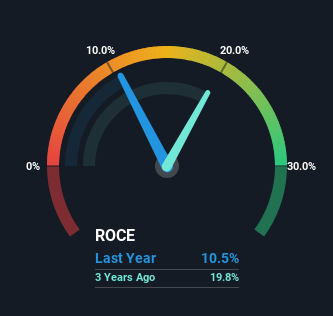- Saudi Arabia
- /
- Trade Distributors
- /
- SASE:9533
Saudi Parts Center (TADAWUL:9533) Is Reinvesting At Lower Rates Of Return

To find a multi-bagger stock, what are the underlying trends we should look for in a business? Firstly, we'd want to identify a growing return on capital employed (ROCE) and then alongside that, an ever-increasing base of capital employed. Ultimately, this demonstrates that it's a business that is reinvesting profits at increasing rates of return. In light of that, when we looked at Saudi Parts Center (TADAWUL:9533) and its ROCE trend, we weren't exactly thrilled.
What Is Return On Capital Employed (ROCE)?
For those that aren't sure what ROCE is, it measures the amount of pre-tax profits a company can generate from the capital employed in its business. Analysts use this formula to calculate it for Saudi Parts Center:
Return on Capital Employed = Earnings Before Interest and Tax (EBIT) ÷ (Total Assets - Current Liabilities)
0.10 = ر.س6.0m ÷ (ر.س105m - ر.س48m) (Based on the trailing twelve months to June 2024).
Thus, Saudi Parts Center has an ROCE of 10%. In isolation, that's a pretty standard return but against the Trade Distributors industry average of 16%, it's not as good.
See our latest analysis for Saudi Parts Center

While the past is not representative of the future, it can be helpful to know how a company has performed historically, which is why we have this chart above. If you'd like to look at how Saudi Parts Center has performed in the past in other metrics, you can view this free graph of Saudi Parts Center's past earnings, revenue and cash flow.
How Are Returns Trending?
When we looked at the ROCE trend at Saudi Parts Center, we didn't gain much confidence. Around four years ago the returns on capital were 24%, but since then they've fallen to 10%. Although, given both revenue and the amount of assets employed in the business have increased, it could suggest the company is investing in growth, and the extra capital has led to a short-term reduction in ROCE. And if the increased capital generates additional returns, the business, and thus shareholders, will benefit in the long run.
While on the subject, we noticed that the ratio of current liabilities to total assets has risen to 46%, which has impacted the ROCE. Without this increase, it's likely that ROCE would be even lower than 10%. And with current liabilities at these levels, suppliers or short-term creditors are effectively funding a large part of the business, which can introduce some risks.
Our Take On Saudi Parts Center's ROCE
Even though returns on capital have fallen in the short term, we find it promising that revenue and capital employed have both increased for Saudi Parts Center. However, total returns to shareholders over the last year have been flat, which could indicate these growth trends potentially aren't accounted for yet by investors. So we think it'd be worthwhile to look further into this stock given the trends look encouraging.
Saudi Parts Center does come with some risks though, we found 3 warning signs in our investment analysis, and 1 of those is a bit concerning...
While Saudi Parts Center isn't earning the highest return, check out this free list of companies that are earning high returns on equity with solid balance sheets.
If you're looking to trade Saudi Parts Center, open an account with the lowest-cost platform trusted by professionals, Interactive Brokers.
With clients in over 200 countries and territories, and access to 160 markets, IBKR lets you trade stocks, options, futures, forex, bonds and funds from a single integrated account.
Enjoy no hidden fees, no account minimums, and FX conversion rates as low as 0.03%, far better than what most brokers offer.
Sponsored ContentNew: Manage All Your Stock Portfolios in One Place
We've created the ultimate portfolio companion for stock investors, and it's free.
• Connect an unlimited number of Portfolios and see your total in one currency
• Be alerted to new Warning Signs or Risks via email or mobile
• Track the Fair Value of your stocks
Have feedback on this article? Concerned about the content? Get in touch with us directly. Alternatively, email editorial-team (at) simplywallst.com.
This article by Simply Wall St is general in nature. We provide commentary based on historical data and analyst forecasts only using an unbiased methodology and our articles are not intended to be financial advice. It does not constitute a recommendation to buy or sell any stock, and does not take account of your objectives, or your financial situation. We aim to bring you long-term focused analysis driven by fundamental data. Note that our analysis may not factor in the latest price-sensitive company announcements or qualitative material. Simply Wall St has no position in any stocks mentioned.
About SASE:9533
Saudi Parts Center
Engages in the wholesale and retail trading of spare parts of trucks and heavy transport, agricultural and industrial equipment, and construction equipment and machinery in Saudi Arabia.
Adequate balance sheet low.
Market Insights
Community Narratives




